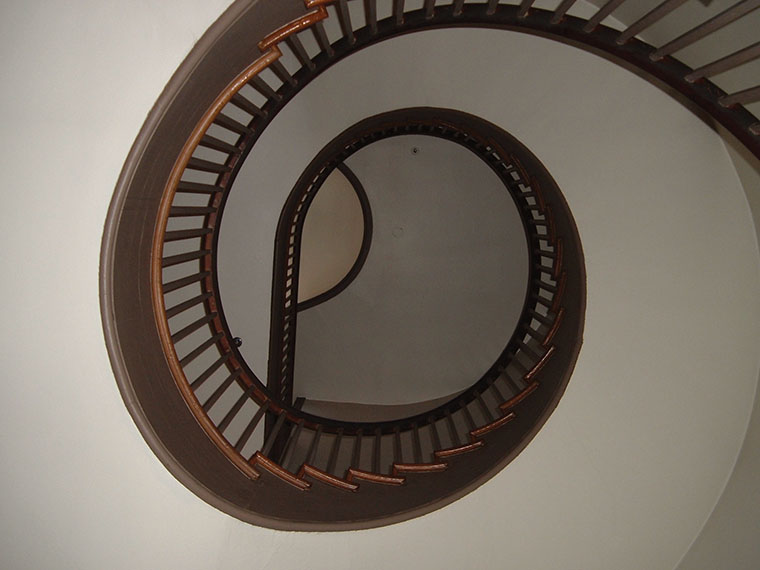By Tim Miller

Shakertown staircase.
The question of generational transition in American communities is inescapably related to one enduring puzzle: although most communities are intended to be permanent institutions, their lifespans in a great many cases aren’t very long. Over and over, people with the highest ideals found intentional communities that turn out to be painfully short-lived. And often communal lifespans are directly related to changing generations. To put it simply, the children of communal founders, and others of the next generation in line, often are not interested in keeping the community going.
Trying to get a good handle on average communal longevity is a formidably difficult task. We have founding dates, or at least approximate dates, for a great many communities, but finding accurate dates of dissolution is much harder. Many communities seem to fade away; eventually someone notices that a community is gone, but no one has noted the date. It is safe to estimate, however, that the average lifespan of American communities would be measured in (at most) years, not decades or centuries. A community that celebrates its 50th anniversary is the exception, not the rule. Some communal groups, such as the Shakers and Hutterites, are powerfully long-lived, but they are the rare exceptions to the rule of short existence.
So if there is a natural, innate human desire for community, why have the intentional communities of the last 400 years on the whole been short-lived? Developing an answer to that question tends to be anecdotal, but I will endeavor to provide a few generalized explanations.
Explanation One: Building is fun; maintenance is not. Communal memoirs that recount the spirit of the founding years usually bristle with energy. Starting a new community is full of great excitement. Such a venture is a daunting undertaking, with major issues of acquisition of property, financing the project, selecting and evaluating members, and many more. These pioneers are traveling to a new land and new way of life. Often there is land to be acquired, and then there are buildings to erect, a food supply to establish, and other essential tasks to complete. But maintaining what has been started seems to be less exciting than building it in the first place. Those who raise money for charitable causes bemoan the fact that donors like to support new initiatives and shy away from paying for routine operations, and a similar dynamic seems to be alive in the world of intentional communities.
Explanation Two: Community founders are typically fairly young, and as they age, they and their communities become less attractive to new young seekers of community. As I have suggested just above, the young energy that seems ideally suited to the building of community will not endure forever. And age discrimination is a reality in our culture. We no longer live in the traditional tribes that value their elders; a great many young people simply do not want to move into a community with an aging population. I once had a student who became a novice sister in a Catholic religious order. Her fervor was great, and she had excellent contributions to make to that well-established and prosperous community. But before long she left, and when I asked her why, she said that the other members were simply too old―she had very few peers, and thus she felt adrift. Perhaps she could have joined others in creating a new community, but what happens then to the old one?
Explanation Three: Too many leaders, not enough followers. People interested in community are often cultural visionaries, and they often have strong personalities and leadership instincts. They often have distinctive and specific visions of community and want other people to unite on the basis of a particular vision. Sometimes that works well, as people find themselves drawn to a particular communal vision or to the person expounding it, but in many cases it doesn’t work out because those who might join a community are busy promoting their own visions. The back pages of Communities magazine are testimony to this problem: every issue has listings of proposed new communities that could take off and fly if only people would unite around this or that particular plan.
● ● ●

House at Libre community, Colorado, a community in existence for over 50 years.
What is the shape of communitarianism as we move forward? No one answer seems to fit. The largest communal movement of all, that of the Catholic religious orders, has been declining in numbers for many years for a variety of reasons, and barring major reforms in the Catholic Church (specifically, allowing its clerical and monastic members to marry), the decline seems likely to continue. On the other hand, our second-largest communal movement, the Hutterites, is thriving, with some 50,000 members in North America (the majority of them in Canada) living in some 500 colonies. Our longest-lived communal movement on American soil, apart from the Catholic monasteries, is that of the Shakers, a tradition that inescapably seems near its end, although it is possible that one or two members may survive to see the 250th anniversary of the arrival of their forebears from England in 1774.
So I am reluctant to generalize or to offer any summary wisdom. I do have confidence that while many communities have short life spans, the communal impulse and form are not about to disappear. I’m reluctant to predict just what that future communal world will look like, however. Although the basics remain the same―people living together on the basis of a common purpose, practicing some level of economic sharing―the details are elastic. Such innovations (or at least modifications of earlier communal patterns) as cohousing and ecovillages seem well poised to be a prominent public face for the intentional communities movement well into the future. And in a society that is aging as never before, communal retirement housing was growing substantially as the 21st century dawned. A full-scale cohousing project or even a shared house with just a few people is far more attractive than a typical nursing home, so who wouldn’t try to pursue that type of community?
In the early years of the 21st century some other variations on the old theme seemed to hold some promise for the future. The largely Protestant movement known as the New Monasticism has captured much of the sacrificial spirit of the great monastic institutions of the past, but with adjustments suited to the times: members can be married, and they don’t have to pledge to stay for a lifetime. The plague of homelessness in the most prosperous societies in history is finding a communal response in little villages of the homeless living in tiny houses. That won’t end homelessness, but it will help. There is no reason not to think that other such innovations will continue to arise.

Martinsdale Hutterite Colony with wind turbines
Communitarianism has proved attractive to a small but highly dedicated group of Americans throughout our common history. It doesn’t seem destined to become America’s standard form of economic and residential organization, but neither does it appear to be disappearing. As long as idealists arise among us, communes will be in our midst.
Note: This article is a revised version of an excerpt from my recent book, Communes in America, 1975-2000 (Syracuse, New York: Syracuse University Press, 2019).
Tim Miller is a research professor of religious studies at the University of Kansas and a historian of American intentional communities, with a focus on the communities of the second half of the 20th century. His most recent book is Communes in America, 1975-2000, published by Syracuse University Press in 2019. An earlier volume in that series is The 60s Communes: Hippies and Beyond. Tim is also author of The Encyclopedic Guide to American Intentional Communities.
Sidebar:
Counting Communal Longevity
Tracking the longevity of intentional communities is a formidably difficult task. A great many communities do not leave good, accessible records. In some cases we can identify, or at least estimate, community starting dates, but finding dates of dissolution is much harder, since many communities just kind of drift away and don’t have clear termination dates. Eventually someone notices that a community is gone, but when did that happen?
To try to figure out just how many communes survive for a generation or longer I turned to my database of 3,000 American communes that have appeared since the early days of European settlement. Using a rather flawed measuring stick to identify communities reaching or approaching generational transition, I counted communities that had been active in three or more different decades, and eventually found just over 800 of them. However, that number is misleading. Many of my long-lived communities are student housing coops, which usually have steady turnover in membership and don’t really face generational transitions, even though they may last half a century or longer. Many more are religious communities, such as Buddhist monasteries, where, again, the resident practitioners tend to come and go even as the institution continues.
But the bottom line remains: a solid majority of communities do not survive for long, or at all, past the founding generation. The problem of transition, to say the least, has not been solved.
―TM
Excerpted from the Winter 2019 edition of Communities (#185), “Passing the Torch: Generational Shifts in Community.”
